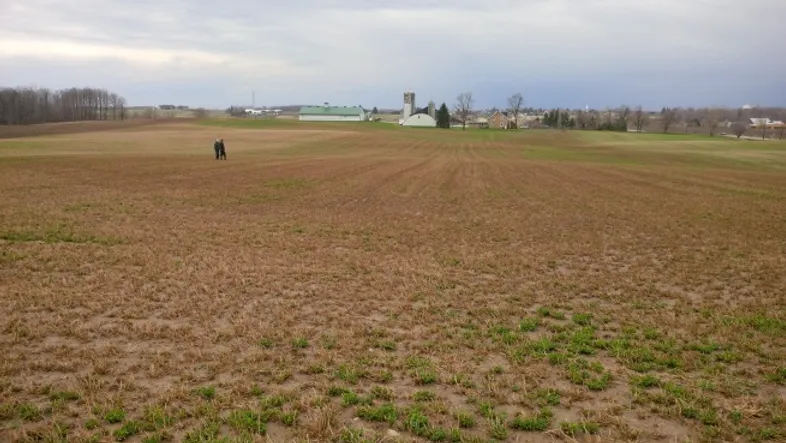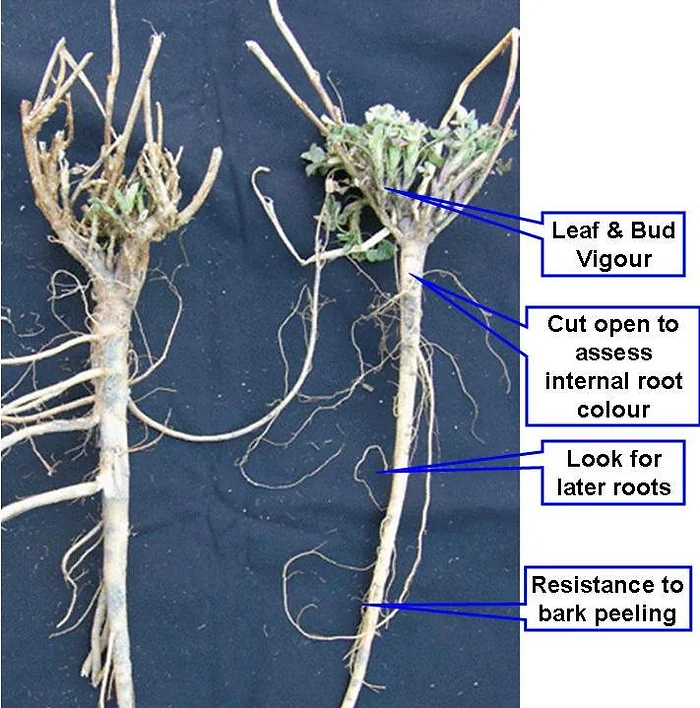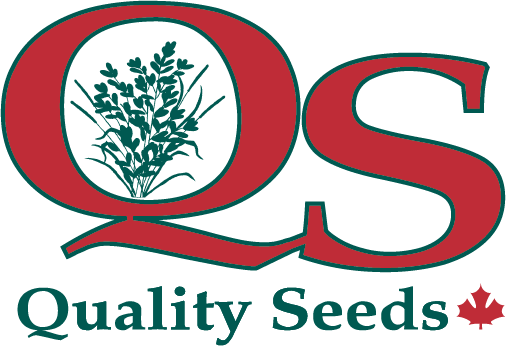Check Alfalfa Stands For Winterkill & Winter Injury

Alfalfa winterkill and severe winter injury are often potential concerns, that result in insufficient forage inventories and forage quality for the coming year. It is difficult to predict alfalfa winterkill, but some years there are more risk factors that come together. Walking fields in early spring to determine if the alfalfa stands have thinned, and assessing if plants are dead or unhealthy is a proactive strategy to determine management options.
When there are increased risk factors for alfalfa winterkill, tight forage inventories, and high land costs, assessing spring alfalfa stand health is essential. Making the decision whether to manage an existing reduced stand or replace it with a new establishment can sometimes be difficult. However, by ignoring the issue you may find yourself with a feed shortage. Don’t wait until it is too late to implement useful options, such as timely reseeding a new stand in the rotation.


Figure 1 – Managing potential alfalfa winterkill requires a proactive approach that includes stand assessment.
Alfalfa Winterkill Risk Factors
Although it is always difficult to predict alfalfa winterkill, some risk factors include:
Weather Factors
- Excessively saturated soils going into winter that become frozen as solid ice. Alfalfa crowns can be severely damaged and turn into mush.
- Alfalfa prefers cool, dry fall weather for good winter hardening. Mild, extended wet falls are often associated with winterkill or injury the following spring.
- Winter temperature fluctuations with little snow cover to provide insulation, very cold temperatures, ice sheeting and water ponding.
- Alfalfa can sometimes break dormancy in winter and become damaged with subsequent cold temperatures.
- Late-winter freeze-thaw cycles can result in alfalfa heaving.
Management Factors
- Older alfalfa stands that appeared stressed the previous year with poor yields.
- Poor soil fertility or low pH.
- Poor soil drainage.
- Aggressive 4-cut systems that include a cutting during the Critical Fall Harvest Period are at a higher risk of winterkill and stand thinning than 3-cut systems.
Refer to the OMAFRA Factsheet, Risk of Alfalfa Winterkill.
Check These Fields First
The higher risk alfalfa fields to check first are:
- older stands,
- fields that are slow to green-up,
- poorly drained fields,
- fields with low fertility or pH, and
- fields that were aggressively cut last fall during the Critical Fall Harvest Period.
Dig & Check For Plant Health
Assessing whether to keep an alfalfa stand or not, can begin in early spring at green-up after the plants have broken dormancy. It is very important to consider the health of alfalfa plants, in addition to plant or stem densities. Inspect fields in several locations. Dig up plants with a shovel to get at least 6 inches of root. Using a sharp knife, slice the crown and root longitudinally. (Figures 2 & 3)
Look for:
- large, symmetrical crowns with good leaf and bud vigour,
- resistance to bark peeling
- lateral roots should be healthy and with good nodulation.
- healthy plants will have a good internal root colour (white to cream colour) and firm in texture
- diseased plants will have dark brown, mushy areas of crown and root rot.
Damage from alfalfa winterkill and disease becomes worse with time, not better. Dead or dying plants will not contribute to yield.


Figure 2 – Assessing alfalfa for plant health – things to look for. (Photo credit – Banks, OMAFRA)


Figure 3 – Cut alfalfa crowns and roots to assess internal root colour and texture. (Photo credit – Banks, OMAFRA)
Plant Counts
Counting the number of healthy alfalfa plants (crowns) can give you an estimate of stand density. The limitation of using plant counts is that it doesn’t account for the size of the crown or the number of stems potentially growing from each plant. It also does not consider grass content.
Alfalfa plant populations decline with age, but crowns get larger with more stems. Table 1 provides the minimum number of healthy plants per square foot for a desirable alfalfa stand. Mature stands (3rd year after establishment or older) should ideally have at least 4 plants/sq ft, but crown size and health should also be considered.
Table 1. Alfalfa Plant Count Guidelines (per square foot)


Stem Counts
Stem density is the best indicator of yield potential from a stand. Initially, counting stems per square foot seems very tedious, but with some practice it can be visually estimated fairly easily with reasonable accuracy. The limitation for measuring stem counts is that you can’t do this until there is enough growth to count, about 4 – 6 inches. This may delay your decision and possibly the seeding date of resulting necessary new seedings. Like plant counts, stem count numbers are assuming no significant additional yield contribution from grasses.
As a general rule, at least 55 stems per square foot provide a maximum yield. The critical level of 40 stems per square foot or less will result in a 25% yield reduction and should be rotated.
Alfalfa Frost Heaving
Frost heaving of alfalfa happens when repeated freezing and thawing pushes the tap root and crown out of the soil. Heaving occurs during the winter heave cycle (similar to fence posts), as well as resulting from the spring freeze-thaw cycles. When severe (more than 1 inch or 2.5 cm), taproots are typically broken and unable to pick up enough nutrients or moisture, and stands eventually die. (Figure 4) Refer to “Frost Heaving of Alfalfa”.


Figure 4 – Frost heaving of Alfalfa
What To Do?
The preferred option is usually rotation and seeding a new alfalfa stand. In an emergency situation because of an immediate need for feed, extending the life of a winter injured stand for that year can sometimes be done by interseeding other species. Refer to “Forage Options Following Alfalfa Winterkill”.
When terminating an injured stand and replacing it by seeding a new forage stand in the rotation, consider the alfalfa forage benefits to the corn crop following in the rotation. OMAFRA conservatively uses a nitrogen credit of 100 lbs/acre to the corn following a forage crop with one-half or more legume content. Research has also shown a rotational benefit to the corn crop following alfalfa of a 10 – 15% increase in corn yield. Adding these benefits together in a period of high corn and nitrogen prices, the forage stand can provide nitrogen and rotational benefits of over $250/acre to the corn crop. This goes a long way to paying the cost of establishing a new field of forage in the rotation. If in doubt, rotate!
